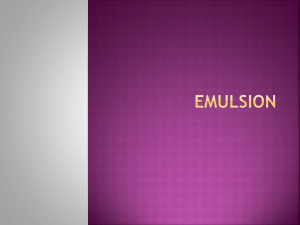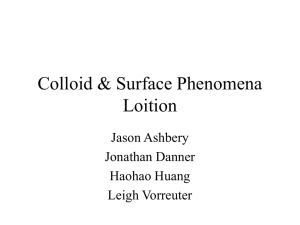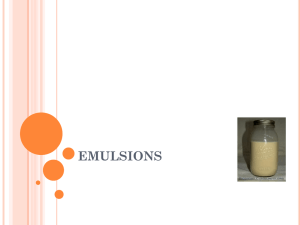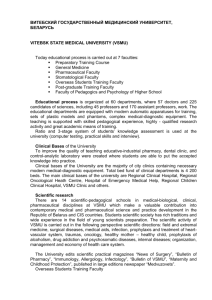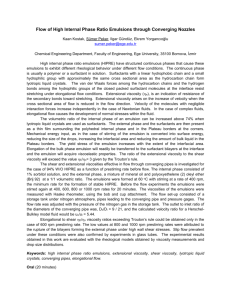8) Introduction to Pharmaceutical Excipients
advertisement
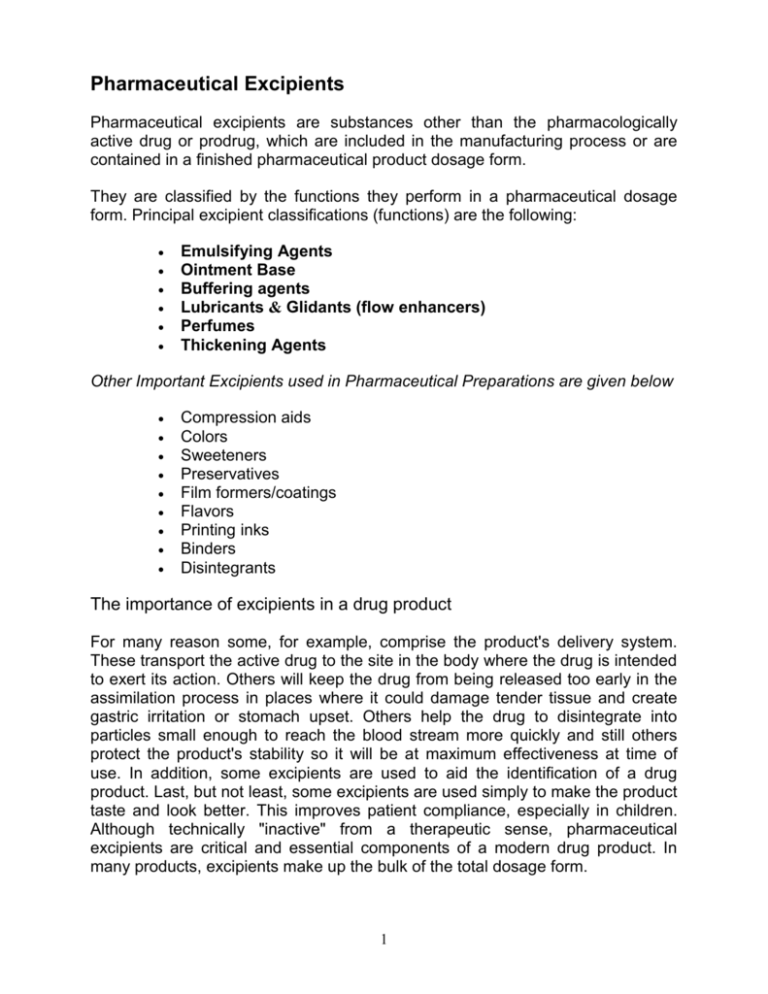
Pharmaceutical Excipients Pharmaceutical excipients are substances other than the pharmacologically active drug or prodrug, which are included in the manufacturing process or are contained in a finished pharmaceutical product dosage form. They are classified by the functions they perform in a pharmaceutical dosage form. Principal excipient classifications (functions) are the following: Emulsifying Agents Ointment Base Buffering agents Lubricants & Glidants (flow enhancers) Perfumes Thickening Agents Other Important Excipients used in Pharmaceutical Preparations are given below Compression aids Colors Sweeteners Preservatives Film formers/coatings Flavors Printing inks Binders Disintegrants The importance of excipients in a drug product For many reason some, for example, comprise the product's delivery system. These transport the active drug to the site in the body where the drug is intended to exert its action. Others will keep the drug from being released too early in the assimilation process in places where it could damage tender tissue and create gastric irritation or stomach upset. Others help the drug to disintegrate into particles small enough to reach the blood stream more quickly and still others protect the product's stability so it will be at maximum effectiveness at time of use. In addition, some excipients are used to aid the identification of a drug product. Last, but not least, some excipients are used simply to make the product taste and look better. This improves patient compliance, especially in children. Although technically "inactive" from a therapeutic sense, pharmaceutical excipients are critical and essential components of a modern drug product. In many products, excipients make up the bulk of the total dosage form. 1 Committees of the U.S. Pharmacopeial Convention Inc., an independent body that publishes and maintains the United States Pharmacopoeia, National Formulary (NF), and USP Reference Standards. The agents that are currently being used in the pharmaceutical field as a very important excipients are discussed below. Emulsifying agents Emulsifying agents are also known as emulgent of emulsifier. They reduce the interfacial tension between the two phases. i.e.; aqueous phase and oily phase thus make them miscible with each other and form a stable emulsion. It is very difficult to select proper emulsifying agents for the development of a stable emulsion. No single emulsifying agents possesses all the properties required for the preparation of stable emulsion therefore sometimes it becomes necessary to use two or more than two emulsifying agents instead of one to get a product of desired qualities. Mechanism of Action Several theories attempt to explain the stability of emulsion. Some of the earliest suggestions considered that the reduction in interfacial tension between the oil and water, caused by adsorption of the emulsifying agent at the interface, was the main stabilizing factor. However, although a relation in these interfacial tensions will facilitate the formation of a disperse system, if the tension still possesses a finite value, coalescence and breaking will lead to a decrease in the total free energy associated with the oil-water interface. Lipophilic Hydrocarbon chain Hydrophilic ionic group Unadsorbed surface-active ion Figure: Adsorption of surface-active ions on top of an oil globule in an o/w emulsion. 2 It has already been pointed out that breaking is the most serious instability of emulsions since shaking does not reverse it. However, it should be noted that the actual coalescence of globules must be preceded by their aggregation of or flocculation. Classification of emulsifying agents Emulsifying agents may be classified as follows: 1. Natural emulsifying agents from vegetable sources. The natural emulsifying agents obtained from vegetable sources are carbohyrates, which include gums and mucilaginous substances. They are anionic in nature and produce O/W emulsions. They are capable of emulsifying a large number of substances but the resulting emulsions will have to be preserved by adding a suitable preservatives, like alcohol, Na benzoate, benzoic acid etc. these preservatives should be added carefully because high conc. of alcohols and solutions of metallic salts may lead to cracking of emulsion. Examples are the following a) Acacia It is the best-known emulsifying agent for the extemporaneous preparations of emulsion for internal use. Emulsions prepared with gum acacia are attractive in appearance, quite palatable and relatively stable. They are stable over wide range of pH (2-10). Emulsions prepared with acacia are susceptible to bacterial growth. The ratio of powdered acacia usually taken for emulsification of fixed oils is 1:4 and for volatile oils is 1:2. b) Tragacanth Tragacanth alone is rarely used as an emulsifying agent but a very stable emulsion is produced if both acacia and traganth are used as an emulsifying 3 agent for the preparation of an emulsion. Tragacanth will render the emulsion more viscous and thereby the rate of creaming will be reduced which is quite high in the case of acacia emulsion. The quantity of traganth required for this purpose is 1/10th of the amount of acacia used. c) Agar Agar is not a good emulsifying agent as it forms a very coarse and viscous emulsion. It is commonly used as a thickening agent along with acacia for the emulsification of mineral oil. Generally 2% Mucilage of agar is prepared by dissolving it in boiling water and cooled to 45oC. d) Chondrus (Irish Moss) Like agar Chondrus (Irish Moss) is also not used as a primary emulsifier but is used as a thichenig agents. Generally it is used along with acacia for the emulsification of cod-liver oil and to mask the unpleasent odor and taste of the oil. A 3% solution used to emulsify an equal volume of the oil. e) Pectin Pectin is a purified complex carbohydrate obtained from the inner rind of citrus fruit and from the pulp of apple and guava. If Pectin alone to be used as emulsifying agent a ratio of 0.1 gm per gram of acacia is sufficient for emulsification of the oil. To prevent the formation of lumps, pectin can be triturated with a small amount of alcohol, glycerol, or syrup before the addition of water. f) Starch Starch is rarely used as an emulsifying agent but the use of starch mucilage is restricted to proportion used as enemas. 2. Natural emulsifying agents from animal sources. a) Gelatin Gelatin is mainly used for the emulsification of liquid paraffin. 1% concentration forms the emulsions. Emulsions so formed are quite white and have an agreeable test. However, gelatin emulsions are prone to bacterial growth therefore a suitable preservative must be incorporated. b) Egg Yolk Egg Yolk itself is an emulsion because of the presence of lacithin and cholesterol, which act as emulsifying agents. It is rarely used in industrial preparations because the emulsions are spoiled during transportation; therefore it is mainly used in extemporaneous preparations meant for internal use. c) Wool fat (Anhydrous Lanolin) Wool fat is generally used in emulsions meant for external applications. it produces water in oil emulsions and can absorb about 50% of water but when 4 mixed with other fatty substances it can emulsify several times its own weight of water. 3. Semi-synthetic polysaccharides. a) Methyl cellulose It is a synthetic derivative of cellulose and widely used in the pharmaceutical industry as suspending, thickening and emulsifying agent. It is available in different forms such as methylcellulose 20, methylcellulose 2500 and methylcellulose 4500. Emulsions prepared with methylcellulose are stable to pH changes and alcohol but may be precipitable in the presence of large amount of electrolytes. b) Na Carboxyl methyl Cellulose Na Carboxyl methyl Cellulose is not used as a true emulsifier but is used as an emulsion stabilizer in the concentration of 0.5-1.0%. It is soluble in cold water as well as hot water. 4. Synthetic emulsifying agents a) Anionic Various alkali soaps, metallic soaps, sulfated alcohols and sulphonats are used as emulsifying agents. They bear a negative charge on them. Among the sulfated alcohols, Na lauryl sulfate is commonly used as emulsifying agent in topical preparations. It produces O/W emulsions. b) Cationic Cationic surface-active agents bear positive charge on them. They are mainly used in the preparations meant for external use such as skin lotions and creams. Quaternary ammonium compounds are the only group of cationic agents that are extensively used as emulsifying agents. These include benzalkonium chloride, benzethonium chloride etc. c) Non-Ionic The non-ionic surface-active agents are widely used in the preparations of pharmaceutical emulsions because the emulsions prepared with non-ionic surfactants remain stable over a wide range of pH. The most commonly used non-ionic surface-active agents are the glyceryl esters such as glyceryl monostearate, poly-oxyethylene glycol. 5. Inorganic emulsifying agents Several inorganic substances such as milk of magnesia, Mg oxide, Mg TriSilicate, Mg aluminum silicate etc are used in the preparations of pharmaceutical emulsions. 5% suspension of bentonite is used as an emulsifying agent. 5 6. Saponins Saponins are rarely used as emulsifying agents. if specially prescribed then quillaia tincture and liquid extract may be used as emulsifying agents. 7. Alcohols a) Cholesterol A number of high molecular weight alcohols are used in emulsion systems primarily for their stabilizing action. Cetly alcohol, Stearyl alcohol, cholesterol may be include in this group. b) Carbowaxes Carbowaxes act as non-ionic emulsifying agents and mainly used in the preparation of ointments and creams. The molecular weight varies from 2001000. c) Lecithins Lecithins forms W/O emulsions but is rarely used as emulsifying agent because it darkness in color when exposed to light and gets easily oxidized. An emulsifier (also known as an emulgent or surfactant) is a substance, which stabilizes an emulsion. Examples of food emulsifiers are egg yolk (where the main emulsifying chemical is the phospholipid lecithin), and mustard, where a variety of chemicals in the mucilage surrounding the seed hull act as emulsifiers; proteins and low-molecular weight emulsifiers are common as well. In some cases, particles can stabilize emulsions as well through a mechanism called Pickering stabilization. Both mayonnaise and Hollandaise sauce are oil-in-water emulsions stabilized with egg yolk lecithin. Detergents are another class of surfactant, and will chemically interact with both oil and water, thus stabilizing the interface between oil or water droplets in suspension. This principle is exploited in soap to remove grease for the purpose of cleaning. A wide variety of emulsifiers are used in pharmacy to prepare emulsions such as creams and lotions. The examples of some emulsifying excipients that are used in pharmaceutical formulation technology are given below. 6 Diethanolamine Chemical Name: Ethanol, 2,2’-iminobis 2,2’-iminodiethanol Empirical Formula: C2H11NO2 Description: At room temperature it is a white solid. Above room temperature it is a clear, viscous liquid with a mildly ammoniacal odor. Typical Properties: Melting Point : 28.0 C Boiling Point : 268.8 C PH (0.1 N solution): 11.0 Solubility : 20.0 C Application in Pharmaceutical Formulation or Technology: It is used for various buffering purposes, including the preparation of emulsions. It has been utilized to form the soluble salts of active compounds. It was reported to solubilize by salt formation slightly soluble iodinated organic acids used as contrast media. Diethanolamine was reported to inhibit the decolorization of aqueous composition containing hexamethylene tetramine-1,3 Dichloropropene salts. Cetomacrogol Emulsifying Wax Description: white or off-white waxy solid or flakes, which melt when heated to give a clear, almost white liquid. Typical Properties: Density : 0.94 gm/cm3 Iodine Value : 0.15-0.16 (BP Method) Application in Pharmaceutical Formulation or Technology: Used as an emulsifying agent in the production of o/w emulsions which are unaffected by moderate concentrations electrolytes and are stable over a wide pH range. The concentration of wax used will alter the consistency of the product due to its self-bodying action. Example: Chlorhexidine cream BP. 7 Cetostearyl Alcohol Chemical Name : Cetostearyl Alcohol Empirical Formula : C18H38O Description: Cetostearyl Alcohol is a mixture of solid, aliphatic alcohol and consists mainly of stearyl and cetyl alcohols with small quantities of other alcohols. Typical Properties: Boiling Point: Not below 300 C Solubility: Insoluble in water, soluble in solvent ether. Application in Pharmaceutical Formulation or Technology: Cetostearyl Alcohol is used as a consistency imparting agents and emulsifier in both o/w and w/o emulsions. It acts as a stabilizer when mixed with more hydrophilic primary emulsifiers. It is also used in the preparation of non-aqueous creams and sticks. Example: Paraffin ointment BP Ointment Bases Ointments are soft semi-solid preparations meant for external application to the skin or mucous membrane. They usually contain a medicament or medicaments dissolve, suspended or emulsified in the base. Ointments are used for their emollient and protective action to the skin. They are also used as a vehicles or bases for the topical application of medicinal substances. Ointment Bases: The ointment base is the substance or part of an ointment, which serves as a carrier or vehicle for the medicament. The characteristics of an ideal Ointment are the following. 1. It should be chemically and physiology stable. 2. It should be smooth and free from grittiness. 3. It should melt or soften at body temperature and be easily applied. 4. The base should be non-irritating and should have no therapeutic action. 5. The medicament should be finely divided and uniformly distributed throughout the base. Since there is no single ointment base available, which possesses all these 8 qualities, therefore it becomes necessary to use more than one ointment base in the preparation of ointments. Classification of Ointment bases: The Ointment bases are classified as follows: 1. 2. 3. 4. Oleaginous Bases Absorption Bases Emulsion Bases Water Soluble Bases 1. Oleaginous Bases These bases consist of water insoluble hydrophobic oils and fats. The most important are the hydrocarbons, i.e. mineral oils, petrolatum and paraffin. The animal fat includes lard. The combination of these materials can produce a product having desired melting point and viscosity. The Oleaginous bases are decreasing in flavor due to the reasons described as below: a) They are greasy. b) They are difficult to remove both from skin and clothing’s. c) The release of medicaments is not certain. d) If some animal fat included it may get6 rancid. e) Fatty mixture bases prevent drainage on oozing areas and also prevent evaporation of cutaneous secretions including perspiration. The water retention increases the heat in the particular areas. 2. Absorption Bases The term absorption is used to denote the hydrophilic characters of the bases. These are generally anhydrous bases, which can absorb a larger amount of water but still retain their ointment like consistency. The following are some of the absorption bases used. i) Wool Fat It is also known as anhydrous lanolin. It is the purified anhydrous fat like substance obtained from the wool of sheep. It is particularly insoluble in water but can absorb about 50% of its weight of water. Therefore, it is used in ointments where the proportion of water or aqueous liquid to be incorporated in hydrocarbon base is too large. Due to its sticky nature it is not used alone but it is 9 used along with other bases in the preparation of a number of ointments. ii) Hydrous Wool Fat It is also known as lanolin. It is the purified fat like substance obtained from wool of sheep. It is a yellowish white ointment like mass with characteristic odor. It is insoluble in water but soluble in ether and chloroform. Hydrous wool fat is a mixture of 70% w/w wool fat and 30% w/w purified water. It is water in oil emulsion. Aqueous liquid can be emulsified with it. iii) Wool Alcohol It is obtained from wool fat by treating it with alkali and separating the fraction containing cholesterol and other alcohols. It contain not less then 30% of cholesterol. It is used as an emulsifying agent for the preparation of water in oil emulsions and it is used to absorb water in ointment bases. iv) Bees Wax It is purified wax obtained from the honeycomb of bees. It is of two types; (a) yellow bees wax and (b) white bees wax obtained by bleaching and purifying the yellow bee wax. It is used in paste, ointments and other preparations. v) Cholesterol It is widely distributed in animal organisms. Wool fat is also used as a source of cholesterol. It is used to increase the incorporation of aqueous substances in oils and fats. 3. Emulsion Bases Emulsion bases are semisolid emulsions having cream like consistency. These are of two types: Oil in water or water in oil emulsions. Some additional amount of water can be incorporated in both the types and still retain soft cream like consistency. The oil in water type emulsion bases are more polar because they can be easily removed from the skin or clothing by washing with water. The water in oil emulsion bases are greasy and sticky, therefore are difficult to remove from the body and clothing’s. Examples of emulsion bases include hydrophilic ointment, rose water ointment and vanishing creams. 4. Water Soluble Bases Water-soluble bases contain only the water-soluble ingredients and not the fats or other greasy substances that’s why sometimes they are known as greaseless bases. They differ from emulsion bases that the latter contain water-soluble and 10 water insoluble components. Since these bases do not contain any fats or oils, they can be easily washed with water from the skin and clothing’s. They are consists of water-soluble ingredients such as polyethylene glycol polymers. Certain other substances that are used as water-soluble bases include tragacanth, gelatin, pectin, silica gel, sodium alginate, cellulose derivatives, magnesium-aluminum silicate and bentonite. In the true sense these substances are not water-soluble but they swell up with the absorption of water. The examples of some ointment excipients that are used in pharmaceutical formulation technology are given below. Stearyl Alcohol Chemical Name : 1-Octadecanol Empirical Formula : C18H38O Description: It is a hard, white, waxy piece, flakes or granules with a slight characteristics and bland odor. Application in Pharmaceutical Formulation or Technology: Solid Doses form: Used in the controlled release formulations. Semi-solid dosages form: Used in ointment and creams to increase viscosity and physical stability. Also used to increase the water holding capacity of petroleum and in combination with hydrophilic emulsions in complex emulsion systems. Polyethylene Glycol Chemical Name: Polyethylene Glycol. Description: Clear, colorless or slightly yellowish viscous liquid. The odor is slight but characteristic and the taste is bitter and slightly burning, Application in Pharmaceutical Formulation or Technology: Solid PEGs are useful as water-soluble ointment bases (e.g. Macrogol ointment BP). As suppository bases admixture of PEGs has the following advantages. 1. The melting point is higher, so that they can withstand exposure to warmer climates. 2. Release of the drug is not dependent upon melting point. 3. Physical stability on storage is better. 4. They are readily miscible with rectal fluids. 11 Petrolatum Empirical Formula: CnH2n+2 Description: Petroleum is a soft mass. White petroleum is white to faintly yellow in color. White yellow petroleum is pale yellow to yellow. Both types are odorless and almost tasteless. Typical Properties: Congealing Point: Between 41 and 51 C Constancy: Between 100 – 300 mm. Viscosity: 98.9 C Application in Pharmaceutical Formulation or Technology: Petrolatum is used primarily as an ointment base. Although it is usually combined with other ingredients to achieve the desired properties, it serves as the primary base for some of the official ointments. It has also been used as a base for ophthalmic ointments. Examples: White ointment, Yellow ointment, hydrophilic ointment etc. Lubricants & Glidants (flow enhancers) Although granules are naturally freer flowing than powdered material, their flow properties can be improved by coating them with certain materials added in the form of fine powder. These materials are often collectively known as lubricants. In fact, a lubricants is normally added for a variety of reasons1. To improve the flow properties. 2. To reduce friction between the tablet and the die wall of so that the ejection is facilitated. 3. Often to improve the bonding of the granules so as to form a better and stronger tablet. 4. To reduce the tendency of the granules to adhere to the punch surface. If this occurs the tablet may well have a pitted appearance. Strictly ‘lubricant’ is functioning as an anti-adherent if it prevents this occurring. Some authorities prefer to use the term ‘Glidant’ for an inclusion that improves granule flow properties and to reserve the term ‘lubricant’ for an inclusion that serves the other purposes. 12 Lubricants are usually added for a proportion of 1 to 2 % to the dried granules by gently tumbling them together in a drum type mixture. The aim is to coat the granule surface lightly without causing the granule to be disintegrated. The most popular lubricants are stearates of divalent metal such as calcium and magnesium. Other long chain fatty acids an their salts are almost as the good as the stearates. The efficiency of magnesium stearates and other fatty acids salts are due to the largely to their polar nature. Talc, on the other hand, is an example of laminar lubricant, where the action is depends on the presence of fairly thick film on the die wall. Importance of lubricants in suppository preparation It may be difficult to remove theobroma oil suppositories without damaging their surface unless a lubricant is used. Lubricant is necessary for glycerol-gelatin bases because of their sticky nature. A lubricant must differ in composition from the suppository base, otherwise it will be absorbed and fail to provide a buffer film between the suppository and the metal. Watch should be kept for incompatibilities between lubricants and medicaments. In industry, silicone fluids are sometimes used as lubricants. The examples of some lubricating excipients that are used in pharmaceutical formulation technology are given below. Glycerin Chemical Name : 1,2,3 – Propanetriol, Porpane 1,2,3,- triole. Empirical Formula: C3H8O3 Description: It is a clear, colorless and odorless and hygroscopic liquid. Typical Properties: Flash Point: 177 C Boiling Point: 290 C Melting point: 17.9 C Viscosity: 1490 cps at 20.0 C Application in Pharmaceutical Formulation or Technology: Emollient concentration Upto 30% Preservatives in liquid pharmaceuticals above 20% 13 Polyethylene Glycol Chemical Name: Polyethylene Glycol. Description: Clear, colorless or slightly yellowish viscous liquid. The odor is slight but characteristic and the taste is bitter and slightly burning, Application in Pharmaceutical Formulation or Technology: Solid PEGs are useful as water-soluble ointment bases (e.g. Macrogol ointment BP). As suppository bases admixture of PEGs has the following advantages. 1. The melting point is higher, so that they can withstand exposure to warmer climates. 2. Release of the drug is not dependent upon melting point. 3. Physical stability on storage is better. 4. They are readily miscible with rectal fluids. Talk Chemical Name: Native, Hydrous Magnesium Silicate may contain a small amount of aluminum silicate. Empirical Formula: Mg0(Si2O5)4OH4 Description: a very fine, white to grayish white, impalpable, odorless, crystalline powder. Adheres readily to skin, soft to touch and free from grittiness. Application in Pharmaceutical Formulation or Technology: By the concentration of 1-4% of Talk used as Glidant and lubricant for the manufacture of tablet and capsule. About 90-99% acts as a dusting powder in the preparation. Also about 5-10% of Talk used as filters for tablet and capsule manufacturing procedure. 14 Buffering Agent A buffering agent adjusts the pH of a solution. The function of a buffering agent is to drive an acidic or alkaline solution to a certain pH state and prevent a change in this pH. Buffering agents have variable properties -- some are more soluble than others; some are acidic while others are basic. As pH managers, they are important in many chemical applications, including agriculture, food processing, medicine and photography. Buffering agents can be either the weak acid or weak base that would comprise a buffer solution. Buffering agents are usually added to water to form buffer solutions. They are the substances that are responsible for the buffering seen in these solutions. These agents are added to substances that are to be placed into acidic or basic conditions in order to stabilize the substance. For example, buffered aspirin has a buffering agent, such as MgO, that will maintain the pH of the aspirin as it passes through the stomach of the patient. Another use of a buffering agent is in antacid tablets, whose primary purpose is to lower the acidity of the stomach. Mechanism Of Action The way buffering agents work is seen in how buffer solutions work. Using Le Chatelier's principle we get an equilibrium expression between the acids and conjugate base. As a result we see that there is little change in the concentrations of the acid and base so therefore the solution is buffered. A buffering agent sets up this concentration ratio by providing the corresponding conjugate acid or base to stabilize the pH of that which it is added to. The resulting pH of this combination can be found by using the HendersonHasselbalch equation, which is Where HA is the weak acid and A is the anion of the base. The importances of buffer system in pharmaceutical formulation are the following. Parenteral solutions for injection into the blood are usually not buffered, or they are buffered to a low capacity so that the buffers of the blood may readily bring them within the physiologic pH range. If the drugs are to be injected only in small quantities and at a slow rate, their solutions can be buffered weakly to maintain approximate neutrality. 15 Following oral administration, aspirin is absorbed more rapidly in systemic buffered at low buffer capacity then in systems containing no buffer or in highly buffered preparations. Thus the buffer capacity of the buffer should be optimized to produce rapid absorption and minimal GI irritation of orally administrated aspirin. In addition to the adjustment of tonicity and pH for ophthalmic preparations, similar requirements are demanded for nasal delivery of drugs. Insulin, for example, is more effective by nasal administration than by the other nonparenteral routs. The examples of some buffering excipients that are used in pharmaceutical formulation technology are given below. Citric acid Chemical Name : USP; 1,2,3,-Propanetricarboxylic acid. Empirical Formula : C6H8O7. H2O C6H8O7 Description: Colorless, Translucent crystals or white granular to fine crystalline powder. It is odorless and has a strong acidic taste. It has effervescent in dry air. Application in Pharmaceutical Formulation or Technology: By the concentration of 0.3-.02% improve flavor liquid formulations. 0.3-.02% acts as a suspending and buffering agents and 0.3-.02% also as an antioxidant. Sodium Bicarbonate Chemical Name: Carbonic acid monosodium salt Monosodium carbonate Empirical Formula: NaHCO3 Description: It is an odorless, white crystalline powder with a saline, slightly alkaline taste. A variety of particle size grades of powder and granules are available. Typical Properties: CO2 Yield: Appx. 52% by weight Crystal form: Monoclinic Prism Density: 2.159 g/cm3 pH : 8.3 (0.1N Solution) 16 Melting Point: 270 C Freezing point depressions: 0.396 C (1% w/v solution) Application in Pharmaceutical Formulation or Technology: A concentration of 1.4% Sodium Bicarbonate is used in the preparation of isotonic injection or infusion solution in pharmaceutical field. Also about 25-50% of Sodium Bicarbonate acts as a source of CO2 in effervescent tablet and granules. Including in some injection (e.g. nicotinic acid) of about 40% of Sodium Bicarbonate to form more soluble sodium salts. Sodium Citrate, Dihydrate and Anhydrous Chemical dihydrate. Name: BP Trisodium 2-hydroxypropane -1,2,3,-tricarboxylate Empirical Formula: C6H5Na3O7 2H2O Description: The dihydrate consists of odorless, colorless or white crystalline powder with a cooling saline taste. Typical Properties: Melting Point: 150 C Solubility: Very soluble in water, Insoluble in alcohol. Crystal structure: Monoclinic pH of aqueous solution: appx. 8 Density: 1.19 g/cm3 Application in Pharmaceutical Formulation or Technology: A concentration of about 0.3 –2.0 % of Sodium Citrate used as a buffering agent in various pharmaceutical formulation like syrup, tablet etc. Also a concentration of 0.3 –2.0 % of Sodium Citrate may acts as sequestering agents. 17 Thickening Agents Thickening agents, or thickeners, are substances which, when added to a mixture, increase its viscosity without substantially modifying its other properties, such as taste. They provide body, increase stability, and improve suspending action. Thickening agents are often food additives. Food thickeners are frequently based on polysaccharides (starches or vegetable gums) or proteins (egg yolks, demi-glaces, or collagen). Common examples are agar, alginin, arrowroot, collagen, cornstarch, fecula, gelatin, guar gum, katakuri, locust bean gum, pectin,rehan, roux, tapioca, and xanthan gum. The examples of some thickening excipients that are used in pharmaceutical formulation technology are given below. Hydroxyethyle Cellulose Chemical Name: Cellulose, 2-hydroxyethylether. Cellulose hydroxyethylether. Empirical Formula: (C12H21 5O8) n Description: Lighten or cream to white powder. It is odorless and tasteless. It may contain suitable thickening agents. Application in Pharmaceutical Formulation or Technology: It is an effective film former, binder, thickener, stabilizer and dispersant in shampoos, hair sprays, neutralizer, creams and lotions. The concentration to be used is dispersant on the solvent and molecular weight of the grade used. Propylene Glycol Alginate Chemical Name: Propylene Glycol ester or alginate acid. Empirical Formula: (C9H14 O7) n Description: White to yellowish fibrous or granular powder that is practically odorless and tasteless. Typical Properties: Propylene Glycol alginate dissolves in water, in solutions of dilute organic acids, depending upon the degree of esterification. The viscosity of 18 1% solution varies from 21cps to 400cps. It is more stable in the pH range of 3-6. In alkaline solutions, the ester is rapidly saponified. Application in Pharmaceutical Formulation or Technology: Propylene glycol alginate is used as a stabilizer, thickener, suspending, gelling and emulsifying agent in the concentration range of 1-5 depending on the system under study and the grade or type of alginate product employed. Perfuming Agents Perfuming and flavoring agents can be obtained from either natural or synthetic sources. Natural products include fruit juice, aromatic oils such as peppermint and lemon, herbs and spices and different fractions of these. They are available as concentrated extracts, alcoholic or aqueous solutions, syrups or spirits, and are particularly widely used in the manufacture of products of extemporaneous use. Artificial perfumes and flavors are the purity synthetic origin. They tend to be cheaper, more readily available and more stable than natural products. They are usually as alcoholic or aqueous solution or as powder. In some cases there is a strong association between the use of a product and its perfume content. For example, products intended for the relief of indigestion are often mint flavored. This is because for many years mint has been used for such products for its carminative effect. Similarly, the odor of the terpineol is often associated with antiseptic activity. The fact that personal preferences for flavors and perfume often vary with age can also aid the formulator. Children, in general, prefer fruity tastes and smells, whereas adults choose flowery odors and acid flavors. Other suitable materials for the masking of unpleasant taste include menthol, peppermint oil and chloroform. Flavor enhancing agents such as citric acid for citrus fruits glycine or monosodium glutamate for general use are now becoming more widely used. 19

